2020 is the first year of autopilot in many manufacturers' plans, and all chip manufacturers are actively preparing for the battle. For autonomous driving technology, it can be divided into software and hardware parts. In the hardware part, the chip mainly serves as a data processing task. In the entire automatic driving system, the radar and the camera generate a large amount of data, and the data is given to the chip.
Chip suppliers are an indispensable part of the automotive industry. Just like the car factory wants to buy tires from Michelin, buy spark plugs from Bosch and so on. The same is true for those who develop autonomous driving technology. Professionals do professional things, and chips come from suppliers. So, who is doing the business of autopilot chips? What is the latest progress?
1. Nvidia
Tegra X1
NVIDIA has also launched the corresponding chip Tegra X1 for autonomous driving technology, which surpasses Tegra K1 and A8X. Nvidia said the chip will be used first in the smart car segment and then in mobile phones and tablets.
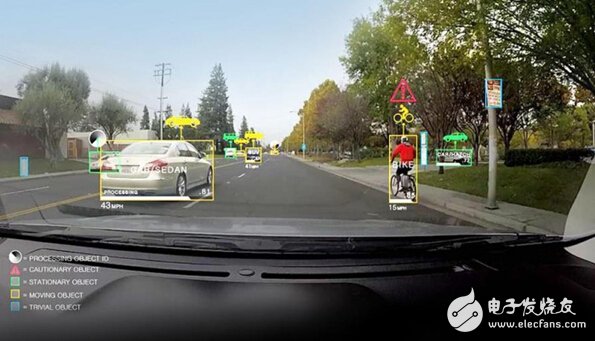
Nvidia DRIVE PX
NVIDIA also has a platform called Nvidia DRIVE PX, equipped with Tegra X1 chip and 10GB of DRAM, which can simultaneously process data generated by 12 2 megapixel cameras (up to 60fps), while DRIVE PX also has deep learning capabilities.
The official claim that the DRIVE PX is smarter than the average ADAS, because it can identify exactly what type of vehicle, such as a police car, a taxi or an ambulance, which is of course essential for autonomous driving.
To show the performance of the Tegra X1, we can compare it with Mobileye's EyeQ3 chip...
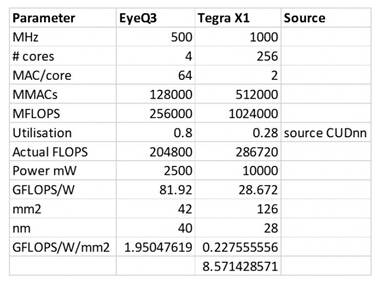
Drive PX 2- Auto Cruise
On September 13th, at the GPU Technology Conference held in Beijing this year, Nvidia CEO Huang Renxun demonstrated the new Autonomous Auto-Driver processor Drive PX 2- Auto Cruise. Simply put, it is a streamlined version of the Drive PX 2 computing platform with a neural network algorithm designed to analyze real-time information collected by multiple radars and sensors on the car, as well as high-definition maps for automated driving.

Drive PX 2 - Auto Cruise
Designed for auto-cruise capabilities, including highway autopilot and HD mapping, the NVIDIA® DRIVETM PX 2 AI computing platform features a new single-processor configuration with a power of only 10 watts to help vehicles with deep neural networks from multiple cameras And sensor data. Baidu will deploy the computing platform as an on-board computer to its automated driving system from the cloud to the car.
2. ST (STMicroelectronics) cooperates with Mobileye to develop
STMicroelectronics is headquartered in Geneva, Switzerland, and its main products are ASICs, microcontrollers, memories and more. The EyeQ3 chip used by Mobileye was developed in cooperation with STMicroelectronics. The two companies started developing ADAS chips in 2005.
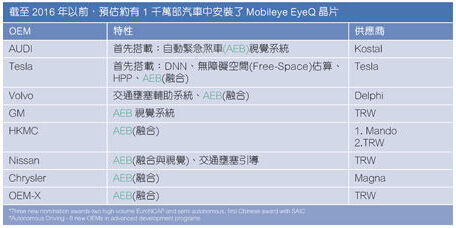
Mobileye EyeQ chip is widely used in cars
(Source: Mobileye)
EyeQ3 uses four multi-threaded MIPS32 cores and four vector microcode processor (VMP) cores to work within an architecture designed to handle video design. Similarly, it is also possible to process image information from multiple cameras. In addition to EyeQ3, STMicroelectronics and Mobileye have also collaborated on the development of the EyeQ3-Lite chip, which belongs to the E version of EyeQ3, which can streamline some functions and achieve the goal of lowering the price.
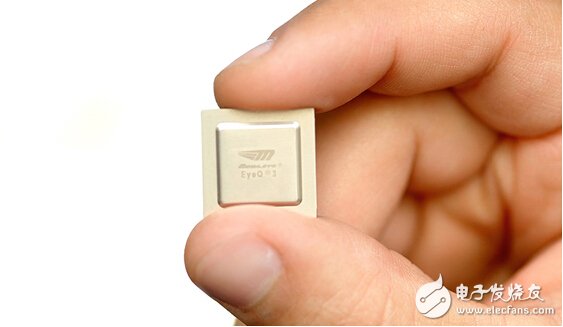
In 2015, Mobileye released the fourth-generation ADAS vision processor EyeQ4, and the related products will be applied in the new off-line models from 2018. The EyeQ4 chip uses 4 core processors, 6 VMP chips (both EyeQ2 and EyeQ3), 2 MPC cores and 2 PMA cores, with floating-point operations of 2.5 teraflops per second, while power consumption is only 3 watt. Through a series of algorithms, EyeQ4 can process image data generated by 8 cameras (up to 36fps) simultaneously, in compliance with ISO-26262 international standards, European NCAP and US NHSTA regulations.
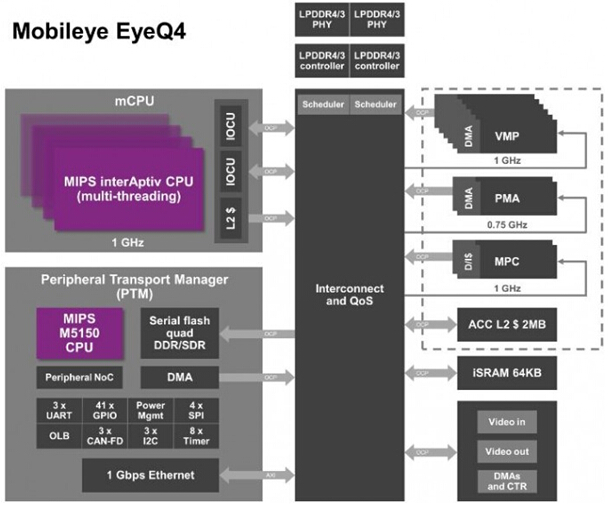
According to reports, in May 2016, Mobileye and STMicroelectronics announced that they will jointly develop Mobileye's fifth-generation system chip, EyeQ5, as the central processor for fully automated driving (FAD) vehicles in 2020, and implement sensor fusion procedures.
In order to achieve power consumption and performance goals, EyeQ5 will be designed with 10nm node or less FinFET technology, multi-threaded 8-core CPU, plus a new generation of 18-core Mobileye vision processor. All of these technology improvements will increase performance by eight times compared to the current fourth-generation EyeQ4. The EyeQ5 consumes less than 5W and can achieve more than 12 trillion operations and passive cooling per second. Engineering samples for EyeQ5 are expected to be available in the first half of 2018.
3. NXP ( NXP)
The Bluebox platform developed by NXP will provide automotive manufacturers with off-the-shelf integrated autopilot computing solutions. BlueBox is a central computing engine designed for autonomous driving. It not only provides artificial intelligence for driverless driving, but also provides interface support for workshop communication and multi-sensors. It acts as a “neural system†for vehicles. It can be easily developed by traditional car manufacturers to develop a four-level driverless car. Autonomous automatic driving without humans.

The BlueBox engine is an open source platform based on the Linux language, which automakers can customize on their own. According to the company, BlueBox has been shipped, and four of the world's top five automakers have already received BlueBox. Since September 2015, the company has shipped these preferred customers.
The BlueBox engine combines radar, LIDAR (laser detection and measurement), visual sensing and a loaded Vehicle to Everything (V2X) system to model the scene around the vehicle and make safety decisions to protect vehicles and passengers. All computing elements use mass production or sample NXP chips to get the system ready.
In an unmanned vehicle system, multiple sensor data streams are fed into the BlueBox engine, and the data streams combine to create a 360° real-time model of the physical environment surrounding the vehicle. The platform has LIDAR systems, radar and vision nodes supported by NXP chips. The NXP S32V processor captures sensor data inputs and creates a map through sensor fusion capabilities. The S32V includes a graphics engine with a high-quality graphics processing accelerator and a car-level functional security engine.
4, TI (Texas Instruments)
From the initial semiconductor component semiconductorization, to automotive entertainment navigation and the rapid development of ADAS, the proportion of automotive electronics in the entire vehicle is gradually increasing. The added value of semiconductor products for automobiles has greatly improved the driving experience of automobiles, and it has also promoted the future of cars to become more intelligent and safe.
Texas Instruments' Jacinto 6 Series Infotainment System Processor (DRA7xx) brings a rich set of in-vehicle infotainment systems, instrument clusters and telematics capabilities to next-generation vehicles with maximum scalability for maximum scalability A common architecture that reuses hardware and software investments.
TI's automotive system-on-a-chip (SoC) solution, TDA2x, provides an open platform that gives customers the flexibility to add their unique value. The TDA2x provides a high-performance architecture for entry-level solutions for front-facing cameras, parking assist, radar and converged applications, enabling customers to save money and speed time-to-market. The TDA3x is primarily used to help automakers develop more sophisticated applications while reducing traffic accidents and enabling more autonomous driving experiences for beginner and mid-level cars.
The intention of expansion in the field of autonomous driving technology is very obvious. In the chip market segment of autonomous vehicles, in addition to well-known companies such as Nvidia, Mobileye, and NXP, there are many “new faces†– such as IP provider Ceva and Intel. And Qualcomm and so on.
5, Ceva, Qualcomm are also actively involved
However, Nvidia is not the only company that promotes deep learning for autonomous vehicles. Ceva is also actively promoting the company's own XM4 imaging and visual DSPs using Ceva's instant neural network software architecture called the Ceva Deep Neural Network (CDNN).
The company's customers will choose a well-trained neural network to pre-process object parameters. By using Ceva's DSP engine, firmware and CDNN, object parameters described by floating-point networks and weights are converted to fixed-point custom networks and weights without loss of precision.
With Ceva's XM4DSP, CDNN allows embedded systems to perform "deep learning tasks, and it can learn three times faster than advanced GPU-based systems, with 30 times less power and 15 times less memory bandwidth." Ceva pointed out.
At CES, Qualcomm announced the Snapdragon 820 automotive lineup that integrates LTE modems and machine intelligence, including Qualcomm's Zeroth machine intelligence platform. The Zeroth project is designed to help automakers use neural networks to create deep learning-based solutions for ADAS and in-vehicle infotainment systems.
But so far, Snapdragon's design orders have been limited to infotainment. Audi chose the Snapdragon 602A processor in the 2017 automotive line.
As Ceva's CEO pointed out, the Snapdragon 820A also provides the Automotive Safety Integrity Level (ASIL) score, which is the risk classification mechanism defined by ISO 26262 - a functional safety rating classification for road vehicle standards.
to sum up
Because the autopilot chip involves driving safety, it has higher requirements on heat generation, life and network security, so it has more technical content than general consumer chips. At the same time, we must also consider the cost issue. In the future, more and more established chip manufacturers should develop autopilot chip business. After all, many OEMs have set the first year of autopilot to be in 2020. Who is not tempted by such a market?
Automotive OEMs are welcoming newcomers to these markets with open arms, Egil Juliussen, director of research at IHS AutomoTIve Entertainment and Advanced Driver Assistance Systems (ADAS), said at CES, “This area has suddenly become very lively.â€
But it is foreseeable that the forces outside the chip industry may have many difficulties in entering this market. Because the industry barriers in this area are relatively high, new disruptors are also hard to come by.

Ac Gear Motor,Ac Geared Motor,Asynchronous Ac Motor,Asynchronous Ac Gear Motor
NingBo BeiLun HengFeng Electromotor Manufacture Co.,Ltd. , https://www.hengfengmotor.com